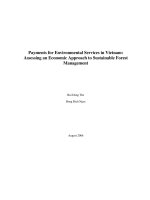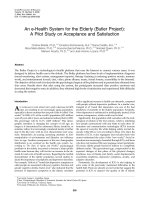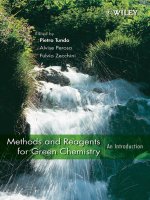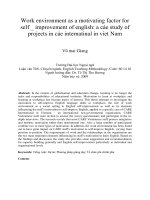Payments for Ecosystem Services: An Introduction and Case Study on Lao PDR
Bạn đang xem bản rút gọn của tài liệu. Xem và tải ngay bản đầy đủ của tài liệu tại đây (113.45 KB, 12 trang )
Payments for Ecosystem Services:
An Introduction and Case Study on Lao PDR
Presentation notes
Michael Esbach and Mike Hedemark
Reproduction of this material is authorized by the recipient institution for non-profit/non-commercial
educational use and distribution to students enrolled in course work at the institution. Distribution may be
made by photocopying or via the institution's intranet restricted to enrolled students. Recipient agrees not
to make commercial use, such as, without limitation, in publications distributed by a commercial publisher,
without the prior express written consent of AMNH.
All reproduction or distribution must provide full citation of the original work and provide a copyright notice
as follows:
“Copyright 2012, by the authors of the material, with license for use granted to the Center for Biodiversity
and Conservation of the American Museum of Natural History. All rights reserved.”
The publication of this material is based on work supported by the National Science Foundation under the
Course, Curriculum and Laboratory Improvement program (NSF 0127506).
Any opinions, findings and conclusions, or recommendations expressed in this material are those of the
authors and do not necessarily reflect the views of the American Museum of Natural History or the
National Science Foundation.
Payments for Ecosystem Services:
An Introduction and Case Study on Lao PDR
Michael Esbach and Mike Hedemark
INTRODUCTION
SLIDE 1
This synthesis presentation serves as an introduction to the concept of Payments for
Ecosystem Services (PES) through a case study on Lao PDR. This gives students a
real-world perspective on the applicability of and opportunities that exist for PES.
2
2
WHAT IS AN ECOSYSTEM?
SLIDE 2
Ecosystems refer to the combination of living organisms and their non-living
environment. Ecosystems are dynamic and complex; they vary in size, richness and
diversity of species, amounts of carbon they store, and how they use and transport
energy. At the same time, ecosystem components are interconnected. Remind students
that humans are an integral part of ecosystems.
WHAT IS AN ECOSYSTEM SERVICE?
SLIDE 3
Humans benefit from a number of fundamental services provided by ecosystems. The
United Nations Millennium Ecosystem Assessment (2005) broadly groups these into
four broad categories: provisioning services (supply of goods giving direct benefit to
people), regulating services (moderate natural phenomena, making ecosystems
sustainable and functional), cultural services (non-material benefit that contributes to the
intellectual, cultural, and social development of people), and supporting services
(consistent, underlying natural processes with indirect or very long-term impacts on
people, which are essential for the production of other ecosystem services, particularly
provisioning services).
GUESS THE ECOSYSTEM SERVICE
SLIDE 4
In order to engage students, go through the pictures and have students explain the
service provided and determine to what category they belong.
Bee pollinating flower (regulating service); timber/lumber for housing/fuel (provisioning
service); dung beetle-nutrient cycling (regulating service); recreation/tourism (cultural
service)
3
3
THREATS TO ECOSYSTEMS
SLIDE 5
Ecosystem services are so fundamental to life that they are easily taken for granted. At
the same time, they are so large in scale that it is hard to imagine that human activities
could destroy them. Yet resource demands from a growing human population place a
large amount of stress on ecosystems. Many human activities disrupt, impair, or alter
ecosystems every day, including the following list.
LAO PDR IN NUMBERS
SLIDE 6
Many students are probably unfamiliar with Lao PDR—a landlocked, mountainous and
thickly forested Southeast Asian country bordered by the Mekong River to the west and
Vietnam to the east. Lao PDR has a relatively small population and intact natural
environment, although forest cover is on the decline. While the economy has a high
growth rate (>7%) the country’s infrastructure is still underdeveloped, especially in rural
areas. Approximately 75% of workers are employed in agriculture, many of whom are
subsistence rice farmers. Economic growth has reduced official poverty rates to 26%
(2010) (CIA Factbook).
ECOSYSTEM SERVICES IN LAO PDR
SLIDE 7
Lao PDR’s natural resources represent a wealth of natural, cultural, and economic
values. Threatening much of this biological richness and diversity is the dominance of
natural resources in the Lao economy, which places enormous pressures on the
integrity of their ecosystems (the country’s top exports are wood products, coffee,
electricity, tin, copper, and gold – the latter three are mined minerals).
Important forest ecosystem services in Lao:
•
4
NFTPs – Non-timber forest products: food for consumption and sale, vegetation
for livestock
4
•
Water
•
Energy: 85% of Laotians get cooking energy from fuel wood
•
Housing material: majority of Lao houses are built with forest material
•
Medicinal: ~80% of population in Asian countries depend on natural medicinal
products (WHO Factsheet #134 2008)
•
Ecotourism
THREATS TO ES IN LAO PDR
SLIDE 8
This slide shows some examples of how ecosystem loss happens. The presenter could
only show half of these and get the students to think of more examples.
NATIONAL PROTECTED AREAS (NPAS)
SLIDE 9
The National Protected Area (NPA) system in Lao PDR was initiated in the late 1980s –
today there are 21 NPAs consisting of representative ecosystems and covering over 3.5
million hectares (15% of total land area). NPAs have three objectives: protection of
forests, wildlife, and water; maintenance of natural abundance and environmental
stability; and protection of natural beauty for leisure and research (Robichaud et al.
2001).
Lao Forestry Law recognizes five types of forest: protection, conservation, production,
rehabilitation, and degraded. Two of these land use classifications are especially
important to NPAs in Lao PDR and national ecosystem services. Protection forest is
intended to protect watershed areas and prevent soil erosion. It also includes areas of
forestland important for national security and protection against natural disasters.
Conservation forest is intended for the conservation of wild animal and plant species,
and has various other historical, cultural, tourism, educational, and scientific values.
5
5
THREATS TO NPAS IN LAO PDR
SLIDE 10
Using a threat assessment methodology (Salafsky and Margolius 1999), five key direct
threats to NPAs were identified and ranked by Lao’s Ministry of Agriculture and Forestry
and the Science, Technology and Environment Agency: slash & burn agriculture,
harvesting of NTFPs for sale, hunting of wildlife for sale, harvesting of NTFPs for food,
and hunting of wildlife for food.
PAYMENTS FOR ECOSYSTEM SERVICES (PES)
SLIDE 11
Ecosystems provide people with a wide range of services that are necessary for their
well-being. At present, however, many of these ecosystem services are either
undervalued or have no economic value. Due to growing concerns, markets for
ecosystem services are beginning to emerge around the world. PES is an intervention
that offers incentives (e.g. money) to farmers or landowners to invest in restoration and
maintenance of a particular ecosystem service. Explain the key attributes of PES (from
Wunder 2005).
WHO ARE ECOSYSTEM SERVICE BUYERS?
SLIDE 12
Explain or have your students come up with different individuals or groups that could be
potential ecosystem service buyers and determine what they are ‘buying’, e.g.
governments buying carbon credits.
WHO ARE ECOSYSTEM SERVICE PROVIDERS?
SLIDE 13
Briefly explain different groups of potential providers.
6
6
CASE STUDY: ELD’S DEER
SLIDE 14
Using the case study from Box 2 in the synthesis, break down the PES scenario into the
key attributes (Wunder 2005) as best as possible. Ask students if they think there are
any issues with this assessment (e.g. perhaps the ecosystem service does not seem
clearly defined).
VALUING ECOSYSTEM SERVICES
SLIDE 15
Through the valuation of ecosystem services, PES brings ecosystems into the economy
and, by extension, our daily lives. It can also serve as a means to protect and restore
ecosystems because it provides a way to justify and determine priorities in programs,
policies, or even actions. Ecosystems are valued by how important they are to people.
The price for an ecosystem service is ultimately determined by what the buyer is willing
to pay and what the seller is willing to accept and deliver.
There are four main values of ecosystem services: social (quantification of economic
benefits from societal POV), financial (costs of developing transaction and/or of making
management changes), alternative cost (see next slide), and market price.
Discuss benefits of valuing ES (recognizing the costs and benefits of ecological
sustainability) and limitations (certain characteristics of ecosystem services that cannot
be expressed in dollar values; from human point of view).
ALTERNATIVE COST EXAMPLE
SLIDE 16
Alternative cost: The actual private financial benefits to specific actor(s) that can be
estimated based on the costs of replacing an ecosystem service if it became damaged
or not available.
7
7
Example: Scientists estimate that up to 65% of the destruction from Hurricane Katrina
could have been avoided if actions had been taken to conserve the shoreline protection
provided naturally by wetlands (WBSCD 2007). [Wetland protection cost: $14 billion vs.
hurricane destruction: $200 billion].
ECOSYSTEM SERVICES VALUES IN LAO PDR
SLIDE 17
Assigning monetary values to the services provided by ecosystems in Lao PDR is a
complex task, but some preliminary efforts have been made. Estimates that exist can be
found in the following table. See corresponding synthesis for explanations and data
resources under section: Ecosystem service values in Lao PDR.
TYPES OF PAYMENTS
SLIDE 18
Listed below are the basic types of payments that can be made for ecosystem services.
Real-world examples of each can be found in the Developing a PES Program section of
the synthesis. See if your students can think of initial or additional examples for each.
WHAT CONTRACT TYPES EXIST?
SLIDE 19
There are many different types of contracts or agreements that can be made between
the buyer and provider. The contract will largely be based on the amount of money
exchanged, the time duration, the measurements and monitoring that is needed, and
trust between the parties. Contracts types include: Memorandum of Understanding
(MoU), legal contracts, customary law agreements, and others. Following is checklist of
common contract components.
8
8
COMMON CONTRACT PARTS
SLIDE 20
While contracts and agreements for PES vary, some parts common to all include the
following list (can be brainstormed by students).
BENEFITS OF PES
SLIDE 21
Some possible benefits from PES include the ones listed on this slide. Additional
benefits could include poverty reduction (discussed in the next slide) and more.
CAN PES REDUCE POVERTY?
SLIDE 22
Lao PDR has a population of 6.3 million people, 80% of whom live in rural areas. Within
this rural population, 26% live below the poverty line (CIA Factbook) and over 75% live
on less than $2 a day (FAO). Currently, there are many incentives that exist for
unsustainable use of resources. In certain contexts, however, PES can provide
incentives for sustainable use of natural resources by providing a reliable source of
income or employment for rural community members. Payments that are delivered
consistently and reliably over many years can create a strong incentive to adapt
sustainable land use practices. Describe the potential various short-term and long-term
benefits of PES.
RISKS TO SELLERS
SLIDE 23
The following is a range of potential risks that exist for the rural poor in entering into
PES deals. Prior to investing in a PES deal, potential sellers and their partners should
conduct a risk assessment to understand the issues relevant to the specific site. It is
9
9
also important to consider the context in which PES deals are currently carried out, as
well as the situations in which PES deals are most relevant and likely to succeed.
NAM ET – PHOU LOUEY (NEPL)
SLIDE 24
The neighboring Nam Et and Phou Louey (NEPL) NPAs cover hilly and mountainous
terrain that hosts the richest biodiversity in northern Lao PDR (ICEM 2003). These
areas contain endemic and threatened species, ecosystems, and natural resources,
provide stability and maintenance for land and water systems, and sustain national,
provincial, and local economies in ways that are only now becoming apparent. A closer
look at NEPL will demonstrate the high economic value of protected areas as well as
the potential for PES programs in Lao PDR and globally.
Explain in detail the opportunities that exist for each of the following in NEPL. Examples
follow on the next two slides for biodiversity conservation and bundling payments. Add
or modify examples to fit your class.
EX: BIODIVERSITY CONSERVATION
SLIDE 25
The push for biodiversity payment programs comes from both an increased recognition
of the role that biodiversity plays in ecosystem functioning, and also a heightened
awareness of the fragility of most ecosystems by the international community. NEPL’s
high biodiversity represents an important gene pool and repository of wild species,
many of which are endemic, rare, or endangered (ICEM 2003). Payments for
biodiversity in NEPL could secure many different services. For instance, payments
could be made to gain access to particular species or habitats, while others could buy
management contracts for habitat or species conservation on private farms, forests, or
grazing lands. Many of the living resources present in NEPL have potential commercial
values for a range of domestic, agricultural, industrial, and pharmaceutical uses
The Cambodia example is from Clements et al. (2010) utilized in Box 13 in the
synthesis. A PES program was established in 2002 for nine bird species in the Northern
10
10
Plains of Cambodia threatened by the collection of eggs and chicks for consumption or
trade by local communities. A program was therefore created in which payments,
sponsored by WCS, would be delivered to local people if nests were protected until the
chicks fledged. Protectors received $1/day for work, as well as an extra $1/day if chicks
fledged successfully (see paper for more detailed explanation). Since the program
started, more than 1,550 nests have been protected in 21 villages over an area greater
than 4,000 square kilometers. Payments total over US $30,000 per year, 71-78% of
which is paid directly to local people. Locals who participate in the program receive
between US $80-160 per year, in a region where typical income is ~$1/day.
EX: BUNDLING PAYMENTS
SLIDE 26
Bundling payments is the organization of multiple services into a single product for a
buyer. This is helpful for conserving large areas, as selling one service may be
insufficient for covering all conservation costs. In addition, bundling can be especially
helpful for biodiversity conservation, as it can be harder to monetize than other services
(e.g. watershed services). For instance, trees fulfill multiple services at once
(watershed services, carbon sequestration, scenic beauty, and biodiversity
conservation).
PROMOTING PES IN LAO PDR
SLIDE 27
Private and government investments in ecosystem services can financially compensate
landowners for protecting and enhancing the nation’s natural capital. Here are several
recommendations for promoting PES in Lao PDR:
1. Bring certainty to the ecosystem marketplace
a. Create a transparent and efficient investment environment that will
encourage outside investment
b. Establish uniform standards and baselines
c. Provide reliable information to all stakeholders (villagers to policymakers)
2. Consider how PES relates to the other strategic plans
a. Integrate into development and forest plans
3. Review legal framework to determine PES applicability
a. Legally clarify rights and ownership over ecosystem services
4. Promote research on PES and related topics
11
11
a. Ecosystem valuation
b. Links with poverty alleviation
5. Pilot PES projects at certain sites
a. Accelerate and lend credibility to emerging markets
LIMITING FACTORS
SLIDE 28
The widespread application of PES in rural areas, including in Lao PDR, is currently
restricted by the following factors: limited access to information; limited organization to
attract buyers; limited access to partners; lack of money for initial costs; lack of
influence to shape or enforce contracts; and lack of financial protection against risks.
IDEAL CONDITIONS
SLIDE 29
A PES intervention should be developed within its local context. Opportunities must be
carefully developed, nurtured and monitored to ensure that the people who need them
most realize the benefits. PES schemes offer an opportunity to safeguard important
natural resources while also contributing to poverty alleviation. While there are a
number of challenges to developing and implementing a PES scheme, the potential for
success does exist, especially in Lao PDR.
12
12









